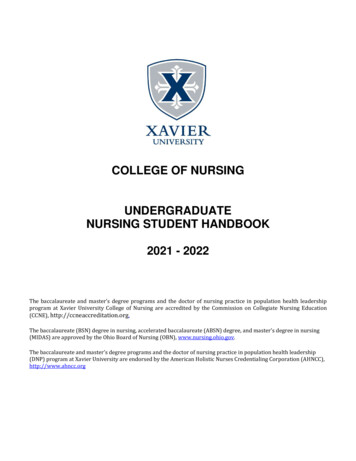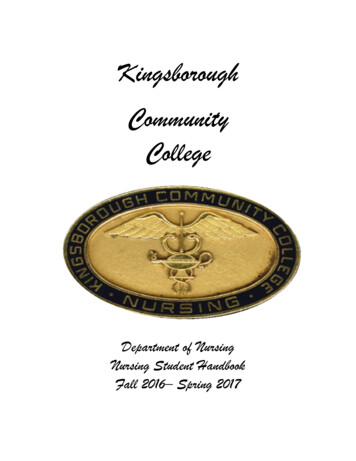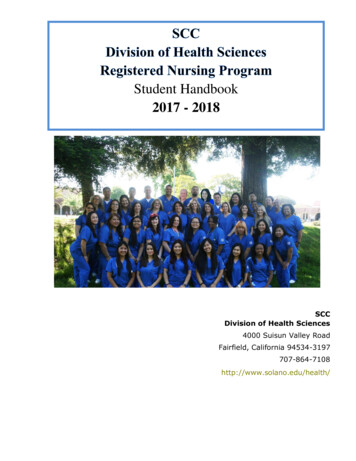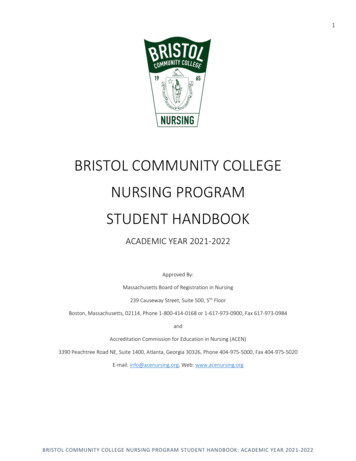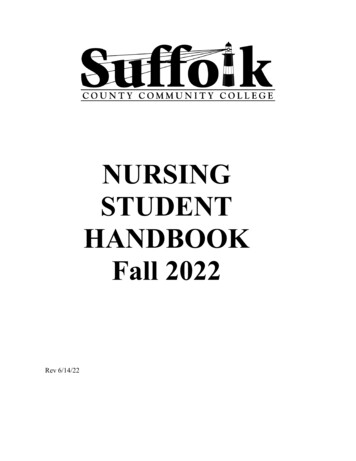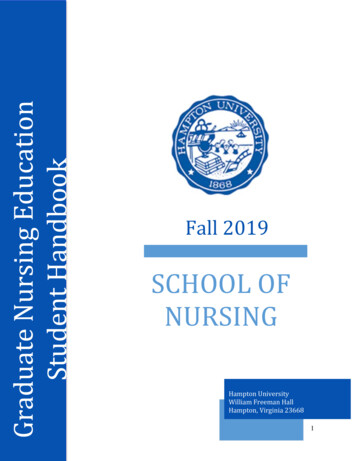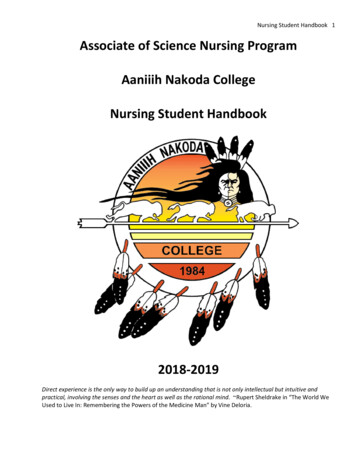
Transcription
Nursing Student Handbook 1Associate of Science Nursing ProgramAaniiih Nakoda CollegeNursing Student Handbook2018-2019Direct experience is the only way to build up an understanding that is not only intellectual but intuitive andpractical, involving the senses and the heart as well as the rational mind. Rupert Sheldrake in “The World WeUsed to Live In: Remembering the Powers of the Medicine Man” by Vine Deloria.
Nursing Student Handbook 2Table of ContentsGeneral InformationMission, Philosophy, Medicine Wheel, Program Outcomes . 3-6Educational Program Approval and Accreditation . . 6Admission and ProgressionAdmission to Aaniiih Nakoda College . . 6Admission to the Nursing Program . 6-7Student Requirements for Nursing Program . 7-10Progression, Students at Risk . 10-11Readmission . 11-12Grievance Process and Chain of Command. 12ASN Curriculum Prerequisites . 13Nursing Program Coursework . 14-15AcademicAdvisors and Retention Counselor . 16Academic Integrity. 16Use of Classrooms and Laboratory . 16Grading and Testing. 17Late Assignments. 17Missed Exams . 17Standardized Testing . 17ClinicalRequired Equipment for Clinical and Classroom . 17-18Professional Appearance for Clinical . 18-19Professional Conduct and Special Considerations . 19-20Student Scope of Practice for the Nursing Program . 20Medication Administration . 20-21Responsibilities of Students Attending Clinical . 21-22Clinical Grading . 22LicensureState Licensure . 22Criminal History and Nursing Licensure . 23AppendicesAppendix A: NSNA Code of Academic and Clinical Conduct . 24Appendix B: NSNA Code of Ethics and Conduct with Interpretive Statements . 25-30Appendix C: ANA Tips for Nurses Using Social Media . 31Appendix D: Care Plan Guidelines, Template, and Grading Rubric . 32-35Appendix E: Clinical Evaluation Tool for Final Clinical Grade . 36-42Acknowledgement & ConsentDepartment of Nursing Acknowledgement and Consent Form . 43
Nursing Student Handbook 3Aaniiih Nakoda College MissionThe mission of Aaniiih Nakoda College is to provide quality post-secondary education for residents of the FortBelknap Indian Reservation and surrounding communities. The college promotes individual and communitydevelopment by maintaining and revitalizing the indigenous lifeways of the Aaniinen and Nakoda Tribes and bypreparing students to succeed in an American technological society.Department of Nursing MissionThe mission of the Aaniiih Nakoda College Associate of Science Nursing Program reflects the college core valuesand is congruent with its Mission and goals. The department adheres to the 'grow our own' philosophy byhelping to empower the student nurse with the attainment of the licensed RN degree. The Aaniiih Nakoda nursewill deliver health care in a holistic and culturally sensitive manner that reflects the community “LifeWays”. Aaniiih Nakoda College nurses will have had state of the art education and technological experiencesbefitting the demands they will encounter practicing in the rural, frontier environment that is their home.Department of Nursing Philosophy: Grow Our OwnAaniiih Nakoda College nursing education program is dedicated to the following: Upholding the Aaniiih and Nakoda “Life Ways” by educating student nurses from the community whoare steeped in the culture, history, and language that is place-based on the Fort Belknap IndianReservation. Employing the indigenous, holistic worldview, embedded in the Medicine Wheel as the teaching andlearning paradigm.Medicine Wheel ParadigmWoven into the nursing education program is the grounding paradigm of the Medicine Wheel, which representsthe holistic and balanced nature of traditional life ways and ways of knowing for cultural groups. This model, inmultiple variations, is common to many American Indian tribes, and is utilized to represent the cycle of life andguide work with individuals, families, or communities from the perspectives of health, education, sociology, orspirituality.The four quadrants or directions (East, South, West, North) represent holistic characteristics which fit with thefour concepts of nursing’s metaparadigm (health, nursing, person, and environment) (Moss, 2016). Eachdirection is represented by a color (yellow, red, black/navy blue, white), a season (spring, summer, fall, winter),a dimension of the person/being (physical, mental/cognitive, emotional, spiritual), and a specific age groupand/or stage of development (infancy/childhood, Adolescence/youth, adult, elder).As the seasons and stages of development cycle with the sun and direction of the clock, the concept of theperson is comprehensive and holistic throughout and across all seasons/stages of development. This carefulbalance of comprehensive, multi-dimensional perspectives from the Medicine Wheel align with the holisticnature of nursing and nursing education.Utilization of these concepts throughout the nursing education program will support cultural safety for both thenursing students and their future patients of culturally diverse backgrounds. Use of the Medicine Wheel toguide the inclusion of culture into the development and implementation of the nursing program upholds themission of the institution to link cultural tradition with contemporary education for ensuring highly competent,safe, and holistic nursing care.
Nursing Student Handbook 4Aaniiih Nakoda College Grow Our Own Nursing Medicine Wheel.Alignment of Medicine Wheel Concepts related to Quality and Safety Education and Practice (QSEN)Competencies (left), Aaniiih Nakoda College Mission and Philosophy (Middle) & National League for Nursing(NLN) Competencies (Right)QSEN CompetenciesMedicine Wheel Concepts –Related to Aaniiih Nakoda CollegeMission and PhilosophyNLN Competencies forGraduates of Pre-licensureNursing ProgramsPatient-centered careHolisticHuman FlourishingTeamwork andCollaborationMulti-dimensional Care(Individual, Family, Community,Environment)Human FlourishingNursing JudgmentProfessional IdentitySpirit of InquirySafetyInformatics,Quality improvement,Evidence-based practiceCultural Safety(Linking cultural tradition &Contemporary knowledge inculturally appropriate manner andin accordance with the ANA Codeof Ethics)Human FlourishingNursing JudgmentProfessional IdentitySpirit of InquiryBalanced Care(physical, mental/cognitive,emotional, spiritual)Nursing judgementProfessional Identity,Spirit of inquiry
Nursing Student Handbook 5Medicine Wheel References: American Nurses Association. (2015). Code of ethics for nurses with interpretive statements. Retrieved /coe-view-only/ Moss, M. (ed.). (2016). American Indian health and nursing. New York, NY: Springer Publishing Company. National League for Nursing. (2018). NLN competencies for graduates of nursing programs. Retrieved from ies-for-graduates-of-nursing-programs. National League for Nursing. (2010). Outcomes and competencies for graduates of practical/vocational, diploma, associate degree, baccalaureate,Master’s, practice Doctorate, and research Doctorate programs in nursing. New York: National League for Nursing. Quality and Safety Education for Nurses. (2018). Competencies. Retrieved from http://qsen.org/competencies/.Department of Nursing Program OutcomesTo meet the challenge of preparing graduate nurses who will have the knowledge, skills and abilities necessaryto continuously improve the quality of the Montana healthcare workforce, the Aaniiih Nakoda ASN StudentLearning Outcomes are based on the Medicine Wheel, the Institute of Medicine (IOM) Future of Nursing Reportrecommendations, the Quality and Safety Education for Nurses (QSEN) competencies, and Montana State Boardof Nursing.Program Student Learning Outcomes:Upon completion of the program, nursing studentgraduates will be able to meet the following programoutcomes:1. Incorporate the philosophy of “growing our own,”the nursing graduate will work collaboratively withclients, their families and the health carecommunity to ensure quality care.References 2. Integrate a Native American cultural focus toadminister culturally competent, patient andfamily-centered care to a variety of clientsthroughout the seasons of their lifespan. 3. Apply the nursing process and incorporateevidence-based practice in providing safe andholistic patient care. 4. Combine cultural, professional, legal, and ethicalaccountability into practice, embracing the valuesof the nursing profession and the Aaniiih andNakoda cultures. 5. Perform at or above the national average on theNCLEX test. Medicine WheelIOM & QSEN (Quality Improvementand Teamwork & Collaboration)Montana State Board of NursingAdministrative RulesMedicine WheelIOM & QSEN (Patient-centeredcare)Medicine WheelIOM (Evidence-based Practice,Safety)QSEN (Evidence-based Practice,Quality Improvement)Montana State Board of NursingAdministrative RulesMedicine WheelIOM & QSEN (Patient-CenteredCare)Montana State Board of NursingAdministrative RulesMontana State Board of NursingAdministrative RulesIOM & QSEN (Utilize informatics)
Nursing Student Handbook 6Educational Program Accreditation and ApprovalThe Associate of Science program has been approved by the Montana State Board of Nursing. Aaniiih NakodaCollege is accredited by the Northwest Commission on Colleges and Universities. After prerequisite courseworkis completed, the Aaniiih Nakoda College (ANC) Registered Nurse Program consists of an additional two years.The actual coursework for the Associates of Science Nursing Program is competency-based and integrated withclinical hands-on experience. The primary goal is to prepare graduates with the knowledge, skills and values toenter the workforce, after successful passage of the national NCLEX license exam given to all students ofnursing.Students commit to a full week at Aaniiih Nakoda College (ANC), at which time they are in class or at clinical forthe fall and spring semesters. This program, while very exciting, is extremely fast-paced and challenging. Thereare many tests, quizzes, and assignments each week, to complete prior to class/clinical outside of class time.The majority of students will find it necessary to spend outside classroom time as well as practicing lab/clinicalskills. A fully equipped SIMS lab is located in the nursing laboratory, on the ground floor of the Tataga Kni(“Returning Buffalo”) building for students to enhance their education and skills needed in patient care. A goodrule of thumb is that for every class hour, at least 3 hours in preparation or in the completion of assignments willbe needed.Admission to Aaniiih Nakoda CollegeStudents must be admitted to the College prior to the submission of the Associates of Science Nursing ProgramApplication. Therefore, no applications will be reviewed unless the applicant applies first to the College andofficial transcripts are reviewed by the Registrar.Acceptance to Aaniiih Nakoda College requires a completed admissions application file, which may be obtainedby visiting the campus, calling the Registrar, (406) 353-2607 Ext. 233, or downloading it from the institution’swebsite http://www.ancollege.edu/?page student services/AdmissionsAdmission and transfer information can also be found in the Aaniiih Nakoda College Student Handbook whichcan be found at http://www.ancollege.edu/?page online resourcesAdmission into the Associates of Science Nursing ProgramTo be eligible to apply for admission into the Associates of Science Nursing Program, applicants must have thefollowing: Show that they have been admitted to Aaniiih Nakoda College and are currently in good standing Completed all prerequisite course work with a minimum overall GPA of 2.5. Prerequisite courseworkcan be taken at other institutions but it is the applicant’s responsibility to confirm those courses areequivalent to the program’s prerequisites and are transferable to this institution (consult with theRegistrar if you have questions) http://www.ancollege.edu/?page student services/registrarNursing Program admission process is outlined in the Associate of Science Nursing Student Information andApplication Packet available in the library and from the Registrar’s office.Students who are applying for admission that have previous bachelor's, master's, or doctorate degrees will beevaluated and advised on a case-by-case basis as to what classes need to be completed in order to be admittedinto the nursing program.
Nursing Student Handbook 7Licensed practical nurses (LPN) who are applying to the Aaniiih Nakoda Nursing Program will be evaluated on acase-by-case basis as to their eligibility to transfer in and potential plans for completing required prerequisites.Placement will be dependent on previous classes taken, classes needed, how long the student has been an LPNand the curriculum in which the student earned his/her LPN licensure.Student Requirements for the Associate of Science Nursing Program1. Liability insurance: Each student must have professional liability insurance while enrolled in theprogram. The cost for this coverage is included in the fees paid each semester. A copy of the liabilityinsurance form is on file with the Nursing Program.2. Fingerprint/Background Checks: Students in the Aaniiih Nakoda Nursing Program will be required toundergo multiple background checks in order to participate with assigned clinical agencies. The processand policy for background checks will be on file with the Nursing Program Administrative Assistant andwill be distributed to students upon acceptance to the Nursing Program. Students are encouraged toreview the Criminal History and Nursing Licensure section at the end of the handbook. Students areencouraged to complete background checks immediately upon acceptance to the nursing program inorder to be able to attend nursing clinicals in the fall. Students will need to start the backgroundcheck/fingerprint process by working with the Nursing Program Administrative Assistant.3. Health requirements:a. Health Insurance Aaniiih Nakoda College requires all students to carry their own medical healthinsurance. Students involved in injury or exposure during the clinical experience should seektreatment in the Emergency Room. Students will be responsible for their own medical expenses.b. Immunizations: In addition to immunizations required for admission to Aaniiih Nakoda College(MMR and negative PPD testing or x-ray verifying absence of contagious disease), nursingstudents will be required to have the following: Flu vaccinations: annual flu vaccinations are required before being admitted to someclinical sites. Students who are allergic to eggs or who have other medical or religiousreasons for not getting the vaccine must wear a mask during their clinical rotation whenthey are within 6 feet of any other person. Annual Tuberculin Skin Testing (TST)*: Required before being admitted to clinical sites.Aaniiih Nakoda College requires a “4-visit” approach for 2-step TB tests:1. Visit 1, Day 1: TST administered2. Visit 2, Day 3: TST test is read (within 48-72 hours of placement). If negative,proceed to 2nd TST. If positive, it indicates a TB infection and a chest x-ray andfurther evaluation from a healthcare provider is necessary.3. Visit 3, Day 7-21: A second TST is applied for those that had a negative TBT onvisit 2.4. Visit 4, 48-72 hours after placement of 2nd TBT, the 2nd TBT is read. If negative,see #5 below. A positive 2nd test indicates TB infection in the distant past. Chestx-ray and further evaluation from a healthcare provider will likely be necessary.5. When you turn in your results to the Department of Nursing at Aaniiih NakodaCollege, please ask your provider to include actual skin test measurements ifthere are any (for a positive or near positive test).6. For your next year in clinical sites at Aaniiih Nakoda College, nursing studentswho had the TST the previous year as nursing students will only be required tohave a one-step Tuberculosis Test the second year.
Nursing Student Handbook 8 Hepatitis B series: Series of 3 vaccinations against bloodborne Hepatitis B virus. Thesevaccinations can be completed at Fort Belknap outpatient ambulatory care or FortBelknap Public Health.c. CPR: A current healthcare providers CPR course will be required before clinical rotations begin.*(per CDC recommendations at: htm?s cid rr5417a1 e )4. Students are required to attend the Nursing Orientation prior to starting nursing classes.5. Attendance: In accordance with the Aaniiih Nakoda College Student Handbook, class attendance is animportant factor in the student’s success at Aaniiih Nakoda College. In fact, upon registering for classes,a student is, in effect, signing a contract in which they are assuming responsibility for attendance andcompleting the class assignments. Attendance is maintained in all classes for financial aid purposes as astudent must maintain a 60% attendance rate in order to receive a Pell grant. Failure to maintain thisrate may affect the amount of Pell grant a student receives and may result in the payback of the Pellfunds. Some instructors require attendance as part of the course requirements for grading purposes.a. Authorized or excused absences do not relieve students of their class responsibilities. When thenumber of absences hinders a student’s progress in a course, the instructor may initiate arecommendation to the Retention Officer to contact the student for withdrawal from the class.b. The Aaniiih Nakoda Nursing Program recognizes the importance of cultural considerations inregards to ceremonies and funeral leave. The Aaniiih Nakoda Advisory Board will determineattendance requirements and excused absences for students in the nursing program so thatclinical and theoretical coursework can be completed.c. Clinical absences must only occur if completely unavoidable. Clinical time will be made up asstudents are required to complete all hours of clinical time per required for clinical classes.6. Freedom from drug and alcohol impairment: The Aaniiih Nakoda Nursing Program will follow theCollege’s no tolerance policy on drugs and alcohol policy, both of which can be found in the AaniiihNakoda College Student Handbook. Any evidence of suspicion of drug or alcohol use is grounds forimmediate dismissal from classroom, lab or clinical setting and may result in dismissal from the nursingprogram. Suspected use of drugs or alcohol, or any other condition or circumstance that constitutesunreasonable risk to the safety and well-being of the patient can result in dismissal from the nursingprogram.7. Physical, mental, sensory, communication, behavioral and cultural requirementsa. Cultural knowledge: Students should be aware of the respect and dignity afforded to all patients and with greatempathy for Seniors and Elders of the Indian Community Students must be aware that silence is a powerful form of communication and learn tomodulate their behavior when interacting with patients Students must realize family and community members need to be close to the patient andtreat non staff in the room as an asset for the patient not a determent for care Students should be able to greet their Aaniinen and Nakoda patients in their own languageand become a patient advocate for them
Nursing Student Handbook 9 Students should have the foundation to ensure the Cultural Safety of their patientsb. Physical demands include being able to: Use computer input and output devices effectively, including typing and data entry Provide all aspects of patient care including medication administration and treatmentsaccording to nursing unit guidelines Physical stamina to work quickly and for long intervals without sitting Turn/reposition bedfast patient, alone or with assistance, to prevent hazard of immobility.This may require lifting with assistance 200-300 pounds. Transfer patients from bed to chair, bed to stretcher, chair to bed as needed throughout shiftalone or with assistance. Transport patients in wheelchairs as necessary Answer patient call lights or intercom system to determine patient needs. Perform CPR – ventilation/compression Spend at least 6 to 8 hours on your feet while delivering care Ability to use left and right hand function, from simple grasping to low speed assembly such aspicking up a lancet and obtaining a blood sample with the lancet to get a fasting blood glucoselevel on a client Do twisting, sitting, standing, walking, bending, reaching, climbing, squatting, kneeling, andreaching under beds during your shift Lift, carry, push, and pull from 1 pound to over 100 poundsc. Mental demands include being able to: Use effective time management Concentrate and maintain acceptable level of accuracy in spite of frequent interruptions Be courteous, tactful, and cooperative throughout the working day Maintain confidentiality with regard to all phases of work Read and write English and do basic math calculations Accept assignments to other nursing units and perform patient care Utilize effective verbal communication Answer the telephone Function in a stressful environmentd. Sensory demands include being able to: Do computer work for hours under artificial light, decipher handwritten and typewritteninformation in medical records Differentiate colors Understand spoken voices and understand various accents, both face-to-face and while usingvarious communication technologies Work in a noisy environment Possess the capabilities to accurately assess patients using auditory, tactile, visual, andolfactory sensese. Communication Effective communication in oral and written forms; Process and communicate information on patient’s status with accuracy and in a timelymanner to members on the health care team, including faculty.f.Behavioral/Emotional
Nursing Student Handbook 10 Student must have emotional stability to function effectively under stress; Must be able to adapt to an environment that may change rapidly without warning and/or inunpredictable ways; Student must know that his/her values, attitudes, beliefs, emotions, and experiences affecthis/her perceptions and relationships with others. Student must be able and willing to examine and change his/her own behavior when itinterferes with productive individual or team relationships; Student must possess skills and experience necessary for effective and harmoniousrelationships in diverse academic and working environments.The above listing is composed of general examples. Specific jobs may have other demands.ProgressionIn the following situations, students may not continue in the nursing program:1. Failure of the same course twice2. Failure or withdraw/ failure of two nursing courses3. Withdrawal from the same nursing course twice4. Less than a minimum cumulative college grade point average (GPA) of 2.05. Less than a grade of “C” in all nursing and core courses.a. Nursing courses are sequential. If a student receives below a ‘C’ in a nursing course, that coursemust be successfully completed before the student can progress in the sequence. Tosuccessfully complete a laboratory or clinical course, a student must meet the passing criteriafor all components of evaluation to pass that course. If criteria are not met, the student will notpass that course. All nursing course and clinical requirements must be met in order to earn agrade of C or better.6. Inability to complete approved standardized testing or additional testing (such as math exams) asrequired by the Nursing Department.7. Dismissal of the student from the nursing program for the following reasons:a. When the student’s health, performance, and/or behavior compromise the safety of patients,students or college personnel. Performance in an unsafe manner while providing care to aclient. In addition, the student will be immediately removed from the clinical areab. Exhibiting conduct that is unprofessional, incompetent, unethical, or illegal in theclinical/practicum settings as outlined by the NSNA Code of Ethics/Code of Academic and ClinicalConduct.c. Committing an act of academic dishonesty such as cheating on examinations, plagiarism, orimproper documentation or falsification of clinical activities as outlined in the ANC NursingStudent Handbook.d. Any lapse in health and liability insurance or CPR certificatione. If any student arrives at the clinical area chemically impaired by drugs or alcohol. In addition,the student will be immediately removed from the clinical area.f. Failure to immediately report a client/care error to the clinical instructor.g. Fraudulent or untruthful charting in a medical record.h. Failure to protect client confidentiality.A student who is not able to progress will no longer be considered to be in the Nursing Program and mustreapply for readmission to the Nursing Program. The Nursing Department will request supporting documentsfor readmission. The student must demonstrate the ability to be successful, explain the reason or circumstancethat prevented them from progressing and present a plan that clearly shows the steps they have taken to assure
Nursing Student Handbook 11that their individual situation has been remedied. An application for readmission is due by June 15 forreadmission to the following academic year. A student may be readmitted one (1) time only.Students at RiskStudents who are struggling academically and/or clinically will be monitored closely in the nursing program andrequired to complete a plan of action for performance improvement. The following circumstances include, butare not limited to, examples of when a plan of action for performance improvement will need to beimplemented to advocate for student success in the nursing program: Exam and homework grades that are falling below 75% Attendance issues:o Missing more than one didactic classo Missing any one scheduled clinical dayo Missing scheduled exams Tardiness – clinical, class and/or exams Lack of completion of assigned class work Low scores on standardized exams (Kaplan) Lack of compliance with criteria noted in any of the following: Aaniiih Nakoda College StudentHandbook, Aaniiih Nakoda Nursing Student Handbook, NSNA Student Code of Academic and ClinicalConduct, NSNA Code of Ethics An “Unsatisfactory” for a clinical day as noted on daily clinical evaluationA plan of action for performance improvement will require a meeting between the instructor and the studentdocumenting specific concerns about the student’s current performance and a plan for improvement aboutimmediate concerns. Recommendations will be made by the instructor and the student will have opportunity todocument additional information regarding concerns and plan for improvement. Plans of action forperformance improvement will be shared with the Nursing Program Director.Readmission1. Students who withdraw or fail to successfully complete any nursing course must apply for readmissioninto the program. This application should be in the form of a letter detailing:a. Classes student needs to retakeb. What semester and year student did not successfully pass nursing classesc. Plan of study for how the student plans to successfully complete required classes, includingthose that are needing to be ret
Nursing Student Handbook 1 Associate of Science Nursing Program Aaniiih Nakoda College Nursing Student Handbook 2018-2019 Direct experience is the only way to build up an understanding that is not only intellectual but intuitive and practical, involving the senses and the heart as well as the rational mind. Rupert Sheldrake in The World We

